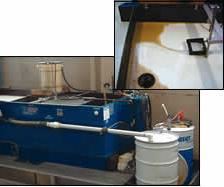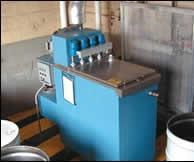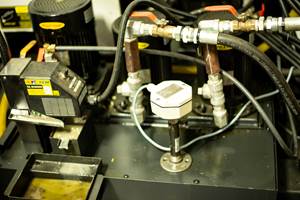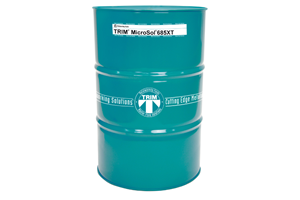Doing Away With Coolant Disposal
This shop installed a series of improvements that eliminated spent coolant waste.
Share




Hwacheon Machinery America, Inc.
Featured Content
View More
ECi Software Solutions, Inc.
Featured Content
View More
.png;maxWidth=45)
DMG MORI - Cincinnati
Featured Content
View More
Autodesk, Inc.
Featured Content
View More
The largest machine shop at the Los Alamos National Laboratory (Los Alamos, New Mexico) employs about 70 people and has about 50 large machine tools. This shop—the Engineering Science & Applications Division Weapon Materials and Manufacturing (ESA-WMM) machine shop—supplies parts needed for scientific research projects. It also makes components of special devices including satellites, robots and biotechnology-related instruments. Some of the jobs are unusual, in other words, but the range of materials is not. The shop machines aluminum, various steels, copper, plastics and composites.
And just like any shop that processes these materials, this shop faced the problem of how to dispose of coolant contaminated with oil. This coolant had to be packaged, labeled and sent to a proper hazardous waste disposal site. In the past, the shop generated more than 3,000 gallons of contaminated coolant per year.
Now spent coolant waste has been eliminated. Fred Algarra, manager of the maintenance support unit for the ESA-WMM shop, worked to realize this success through a series of gradual improvements aimed at not only reducing waste but also improving employee safety. The Los Alamos National Laboratory recognized this success with a Pollution Prevention award. The coolant-related cost savings for this shop now approach $100,000 per year.
New Coolant
The first improvement was to change the brand of coolant the shop used. Mr. Algarra learned that one of his workers had high levels of liver enzymes. The mist coolant in the machine this worker used apparently was responsible. The coolant also caused skin rashes on the hands of other employees. And while these employees tended to accept the skin rashes as a normal part of work, Mr. Algarra wanted to find another type of coolant that did not cause adverse health effects.
The new coolant he chose is a water-miscible cutting fluid from Blaser Swisslube (Goshen, New York). The fluid is composed primarily of mineral oil and water. Company representatives joke that the coolant is safe enough to drink. After all of the old coolant was replaced, employees’ rashes disappeared, and the employee who had the problem with liver enzymes saw these enzymes return to normal levels.
Yet another safety improvement involved coolant additives. The new coolant needs only tiny amounts of the inert additive calcium acetate to reduce foaming caused by soft water. Reduced use of this additive decreases the chance of health risks.
However, this coolant still does become contaminated during normal operation. The accumulation of metal shavings and tramp oil generally requires the coolant to be replaced every week or two, depending on the machine. The next process improvement was aimed at reducing the waste associated with this regular replacement.
Oil Removal, Part 1
To extend the useful life of the coolant, Mr. Algarra purchased a Hyde recycling unit from Monlan Corp. (Westlake, Ohio). Dirty coolant is first filtered to remove suspended and settled solids, then the Hyde unit uses gravity flow to coalesce the dispersed and free-floating oil. More than 99 percent of the tramp oil is removed to a storage container during the coolant’s first pass through the Hyde unit. Clean coolant accumulates in a tank and can be returned to the machines.
Or more accurately, it can be returned to the machines if there are no other contaminants. In addition to the tramp oil contamination, some of the machinists caused the coolant to become contaminated with chemicals they used to improve the appearance of the finished product. For example, cutting fluids containing trichloroethylene were commonly used, and kerosene was used to make plastic parts shiny without polishing. The Hyde unit cannot remove these contaminants. While the presence of these additives was not important when the contaminated coolant was disposed of, these additives were making reuse of the coolant impossible.
Mr. Algarra began to educate the employees about incompatible chemicals in the coolant. The machine shop stopped ordering chemicals that the coolant supplier said were incompatible. Once the habits of the shop had changed, it became possible for recycled coolant to remain in use for several weeks. It could have remained in use even longer except that bacterial contamination caused the coolant to become rancid. The Hyde unit cannot remove bacteria from the coolant, but the next process improvement could.
Oil Removal, Part 2
The problem with bacterial contamination was addressed by fitting each machine tool with a recycling and aeration unit. The shop used two suppliers for these units, Cool-Clean Systems (Wichita, Kansas) and Design & Manufacturing (Fisher, Illinois). Each of these devices pumps the coolant out of the machine, through the unit and back into the machine. Tramp oil accumulates in a floating layer on top of the coolant. The bacteria responsible for causing unpleasant odors are located in this oil. Once per week, the oil layer is removed from each unit and collected for oil recycling.
For one of these units to be effective, all of the coolant in the machine must be circulated so that all of the oil eventually passes through the system. One problem Mr. Algarra had was that the standard return hose was not long enough to force complete coolant circulation inside the biggest machines. He was able to solve this problem by placing longer hoses onto some of the units so that the coolant was returned as far away from the intake pump as possible.
Mr. Algarra also modified a few machines that had baffles in their coolant pans. The baffles were preventing some of the oil from reaching the aeration unit’s pump, and bacteria in this oil were causing the coolant to become rancid. He solved the problem by cutting small channels along the top of each baffle. Because the oil floats on the surface, these elevated channels allowed oil to pass through.
For best results these units need to operate on a regular schedule. If they run all the time, a lot of energy is required. But if they are shut off at night or over weekends, bacteria will have a chance to grow inside the machines. Mr. Algarra addressed this problem by installing a timer on each unit. This allows the units to operate for 15 minutes every other hour.
Inhibiting bacterial growth allows the coolant to remain in use much longer than what was possible with the Hyde unit alone. Mr. Algarra selected one machine and decided to see how long coolant could be reused with the combination of the Hyde unit and a recycling and aeration unit without cleaning out the machine. The coolant in this test remained uncontaminated for more than a year.
Into Thin Air
The ESA-WMM shop subsequently purchased a water evaporator from Severn Trent Services–Samsco (Goffstown, New Hampshire). This reduced the volume of waste even further. Since machine coolant is approximately 95 percent water, the evaporator works very well to reduce the spent coolant’s volume. Because toxic coolant additives are no longer available at the machine shop, only water volatilizes, meaning the process of evaporation does not cause any air pollution.
Up to 200 gallons of contaminated coolant can be placed in the evaporator, and the volume is reduced by over 80 percent in about 6 hours. The remaining compounds are the oil-based fractions of the coolant along with tramp oil. This oil-based material can be added to accumulated tramp oil and sent to an oil recycler. (Bacterial contamination does not affect the oil’s recyclability.)
Upon the installation of the water evaporator, the machine shop eliminated the entire coolant waste stream. Now that all of the equipment is in place, the shop no longer generates 3,000 gallons of spent coolant waste per year. Instead about 100 gallons of recyclable oil are recovered from the coolant stream. The project has also allowed the machine shop to reduce its purchases of concentrated coolant from approximately 12 drums per year (55 gallons per drum) to only three drums per year. The total estimated annual cost savings from reduced coolant procurement and disposal approach $100,000, and the actual benefits are even greater than this because the figure does not include improved worker health and productivity.
Phasing in all of the new equipment and optimizing the recycling systems in the Los Alamos ESA-WMM shop took place over a period of years, but this same system could be duplicated effectively in any machine shop in a short time. As a result of the demonstrated success in waste reduction, another machine shop—the one at Sandia National Laboratory in Albuquerque, New Mexico—has adopted the same system.
About the author: Sonja Salzman is the technical writer for the Pollution Prevention group at the Los Alamos National Laboratory. She holds an M.S. in environmental science and an M.B.A. with an emphasis in corporate environmental management.
Related Content
Sustainability Project Cuts Costs for Growing Manufacturer
A custom coolant and chip management system has helped Youngers and Sons lower its supply costs, improve its recycling margins and maintain a clean shop floor.
Read MoreManaging Coolant with Skimmers, Refractometers and More
Bacteria-infected coolant harms machines and sickens machinists. Coolant management technologies like skimmers and automated systems counter this tendency.
Read MoreMaster Fluid Solutions Semisynthetic Coolant Inhibits Corrosion
Trim MicroSol 685XT is designed to provide enhanced corrosion inhibition on all ferrous and nonferrous metals.
Read MoreConsiderations for Machining Coolant Care
Coolant care can be simply managed if you know where to pay attention and which hazards to look out for.
Read MoreRead Next
Building Out a Foundation for Student Machinists
Autodesk and Haas have teamed up to produce an introductory course for students that covers the basics of CAD, CAM and CNC while providing them with a portfolio part.
Read MoreSetting Up the Building Blocks for a Digital Factory
Woodward Inc. spent over a year developing an API to connect machines to its digital factory. Caron Engineering’s MiConnect has cut most of this process while also granting the shop greater access to machine information.
Read More5 Rules of Thumb for Buying CNC Machine Tools
Use these tips to carefully plan your machine tool purchases and to avoid regretting your decision later.
Read More






















.png;maxWidth=150)
























